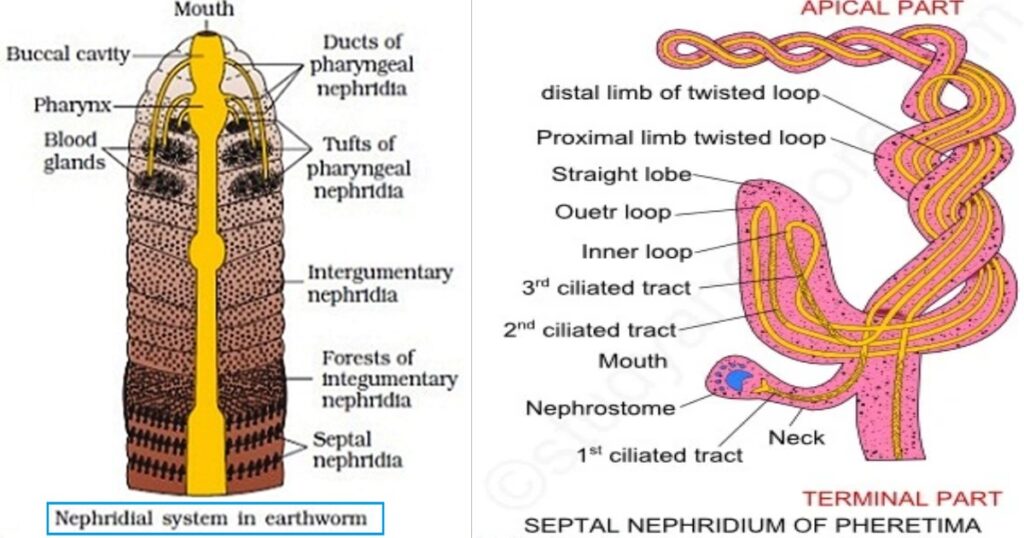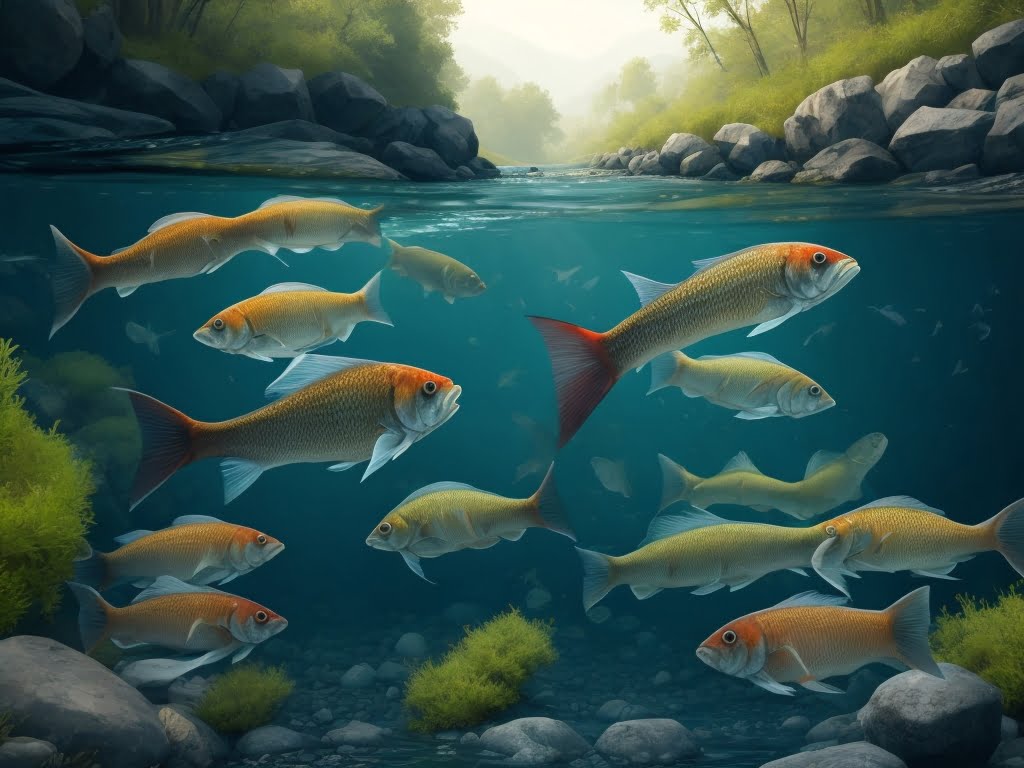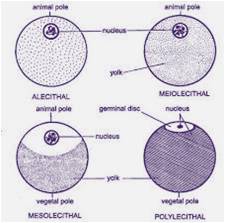Nephridia: Nephridia are excretory organs found in many invertebrates, such as annelids (e.g., earthworms), mollusks, and some arthropods.
Nephridia are excretory organs found in many invertebrates, such as annelids (earthworms), mollusks, and some arthropods. They play a role similar to kidneys in vertebrates, helping to remove metabolic waste from the organism’s body. The basic function of nephridia is the regulation of water and solute balance and the excretion of nitrogenous waste. Let’s break down their structure and functions:
Structure of Nephridia
The excretory organs of earthworms are segmentally arranged slender coiled tubules called nephridia which are ectodermal in origin. The nephridia are found in all segments except the first three. There are of three types according to their location in the body :
1. Septal nephridia;
2. Integumentary nephridia and
3. Pharyngeal nephridia.
1. Septal nephridia. Nephridia are found on the intersegmental septum between 15th and 16th segments, arranged in semicircles around the intestine. Each septum has 40-50 nephridia in front and behind, resulting in 80-100 septal nephridia in each segment, except for the 15th segment with 40-50 nephridia. These are absent in segments up to the 14th.
Structure. The septal nephridia may be considered typical of all the nephridia of Pheretima. Each septal nephridium consists of nephrostome, neck, body of nephridium and the terminal duct.

(i) Nephrostome. The nephrostome, also known as the ciliated funnel or nephridiostome, is a flattened funnel-shaped structure in the coelom of the nephridium. It has an elliptical mouth-like opening leading into a large central cell’s intracellular canal, surrounded by a large upper lip and smaller lower lip, and several rows of small ciliated marginal cells.
(ii) Neck. The nephrostome leads into a short and narrow ciliated canal forming the neck. It joins the nephrostome to the body of nephridium.
(iii) Body of nephridium. The body of nephridium has two parts: a short straight lobe and a long twisted loop. The loop is formed by two limbs the proximal limb and the distal limb. Both these limbs are twisted spirally around each other, the number of twists varies from nine to thirteen. The neck of nephridium and the terminal duct join together and remain connected with the proximal limb of the twisted loop, while the distal limb becomes the straight lobe.
Internally the nephridium is made of a connective tissue matrix having long coiled nephridial duct forming loops. There are four such canals in the straight lobe, three in the lower part and two in the upper part of the limbs of twisted loop. Two canals of the straight lobe out of the four are ciliated like the ciliated canal of the neck.
(iv) Terminal duct. It is short and narrow with a terminal excretory duct. It joins the nephridium with septal excretory canal.
Relation of septal nephridia with intestine. The nephridia hang freely in the coelom and are attached only by their terminal ducts. They open by their terminal ducts into two septal excretory canals lying on the posterior surface of the septum, one on each side of the intestine, each begins ventrally but dorsally it opens in the supra-intestinal excretory duct of its own side.
The supra-intestinal excretory ducts are two parallel longitudinal canals lying above the gut and below the dorsal vessel. These excretory ducts begin from the 15th segment and run to the last segment, they communicate with each other for a short space behind each septum, then either the right or the left duct opens by a ductule into the lumen of the intestine near the septum. Thus, each segment has one such opening into the intestine of either the left or the right supra-intestinal excretory duct. The waste collected by the nephridia is discharged through the excretory canals and ducts into the lumen of the intestine. Such nephridia opening into the intestine are called enteronephric nephridia.
2. Integumentary nephridia. In each segment of the body from 7th to the last segment, numerous nephridia are found attached inside the lining of the body wall. These are called integumentary nephridia which are about 200–250 in each segment except the segment of the clitellar region where they number 2,000–2,500 in each segment.
These nephridia are small-sized, without nephrostome and without any opening into the coelom. Hence, they are called closed type of nephridia. Each integumentary nephridium is V-shaped with a short straight lobe and a twisted loop, its lumen has two ciliated canals. Each nephridium opens by a nephridiopore on the outer surface of the body wall directly. Since the integumentary nephridia discharge the excretory wastes directly outside, hence, they are called exonephric nephridia.
3. Pharyngeal nephridia. These nephridia lie in three paired tufts, one on either side of the anterior region of the alimentary canal in the segments 4th, 5th and 6th. The tufts of pharyngeal nephridia also contain blood glands. Each pharyngeal nephridium is about the size of a septal nephridium but it is of the closed type having no funnel or nephrostome. It has a short straight lobe and a spirally twisted loop, its lumen has ciliated canals. Ductules arise from each nephridium and unite to form a single thickwalled duct on each side in each segment.
The two ducts of nephridia of segment 6th open into the buccal cavity in segment 2nd and the paired ducts of nephridia of segments 4th and 5th open into the pharynx in segment 4th. These nephridia also discharge their wastes into the alimentary canal and are, therefore, enteronephric but such enteronephric nephridia which open into the anterior region of the alimentary canal (buccal cavity and pharynx) are called peptonephridia because they may have taken the function of digestive glands. Recently it has been reported that the pharyngeal nephridia of P. posthuma produce a variety of enzymes like amylase, chimosin, prolinase, prolidase, dipeptidases, aminopeptidase, lipase, etc., which hydrolyse various foodstuffs. Thus, such nephridia work like the salivary glands.
Functions of Nephridia
Earthworms, like other animals, undergo protein catabolism, resulting in the formation of nitrogenous waste substances like amino acids, ammonia, and urea. Uric acid is not present in earthworms, but amino acids are degraded to form free ammonia and urea is synthesized in chloragogen cells. These substances are released into the coelomic fluid and blood for removal. Free amino acids are not excreted, but creatinine traces in urine. In a well-fed earthworm, nitrogen excretion is 72% NH3, 5% urea, and other compounds, while in a starved worm, it is 8.6% NH3, 84.5% urea, and other compounds. In a well-fed earthworm, NH3 predominates nitrogen excretory wastes, making it ammonotelic.
Earthworms excrete nitrogenous wastes in urine, which contains urea, water, ammonia, and creatinine. These wastes are drawn into the nephrostomes of septal nephridia or excretory canals of other nephridia, which are discharged into the intestine or outside by the nephridiopores. Nephridia are also osmoregulatory, helping to conserve water by reabsorption during summers and winters. During rainy seasons, urine is dilute due to lesser reabsorption. other functions are as follows.
1. Excretion of Nitrogenous Waste:
- Nephridia help to eliminate nitrogenous waste, primarily in the form of ammonia, urea, or uric acid, depending on the organism.
- The metabolic breakdown of proteins produces ammonia, which is toxic and must be removed from the body.
2. Osmoregulation:
- Nephridia maintain the balance of water and salts (ions) in the body, crucial for homeostasis.
- They regulate the volume of the body fluids by reabsorbing water and essential ions and secreting excess salts or wastes.
3. Filtration:
- Nephridia act as filtration systems. The nephrostome or flame cells filter coelomic fluid or body fluids to remove waste products and other non-useful substances.
4. Reabsorption and Secretion:
- As the filtered fluid passes through the tubules of the nephridium, essential substances like water, glucose, and ions may be reabsorbed into the body.
- The waste products continue to move through the tubules and are expelled from the body.




